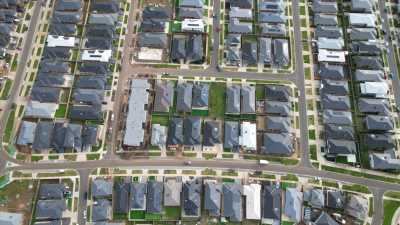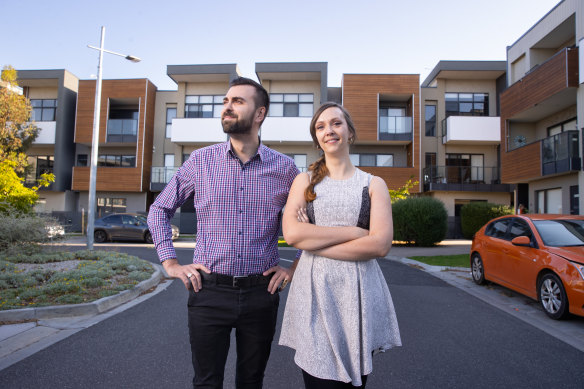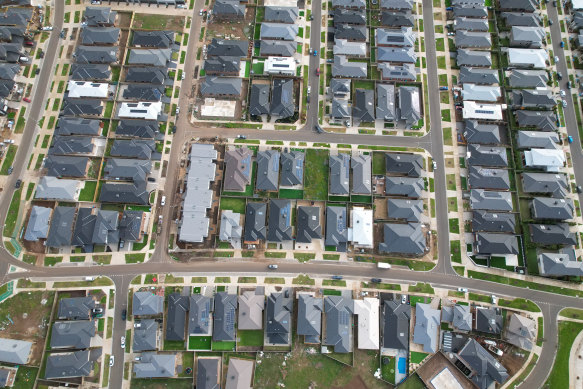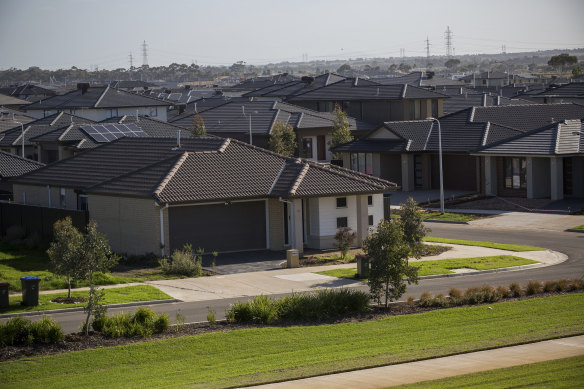The housing design crimes that one Melbourne council wants to punish

Save articles for later
Add articles to your saved list and come back to them any time.
One of Melbourne’s fastest growing councils says its suburbs are blighted by poorly designed homes and has vowed to stop the proliferation of black roofs, double garages and covered outdoor dining areas.
The City of Wyndham on Melbourne’s south-western fringe wants to transform its low-rise urban sprawl and car-choked streets with a new housing plan that seeks to “put the urban into suburban” – encouraging denser, more-walkable neighbourhoods and reviving leafy yards.
Anja Damen and her partner Christopher Locke outside their Point Cook townhouse.Credit: Simon Schluter
It has also put property developers on notice that it may block housing estates from being built more than three kilometres from a train station unless they are connected to rail by a high-frequency peak-hour bus service.
Years of low-rise development have created a spread-out, car-dependent community that is fuelled by plentiful supply of cheaper housing but vulnerable to financial shocks from interest rate and petrol price rises, the council says.
“The costs … are so great that they undermine the capacity for the people of Wyndham to sustain the quality of life they have sought,” the council says.
It hopes its plan will guide urban development across Wyndham for the next 25 years.
The City of Wyndham has a hit list of housing design no-nos including black roofs.Credit: Jason South
The council also warns it may no longer allow new housing estates to be built “out of sequence” from its established plans unless the developer bears the upfront costs of infrastructure.
“A fragmented approach to infrastructure delivery due to too many greenfield areas developing at the same time is creating communities without adequate services such as sufficient kindergartens, schools and tertiary education, local shops and parks,” the council says.
The plan also seeks to tackle the suburban housing styles that have created bland streetscapes and worsen the heat island effect.
“Many new estates are dominated by the double garage to the fronts of dwellings, leaving little space for greenery and minimal passive surveillance of the street,” it says.
“Stylistic trends such as black-tiled roofs, covered alfresco dining areas displacing greenery and open garden space and high site coverage of large dwellings on smaller allotments are factors contributing to urban environments in these new neighbourhoods which are sometimes monotonous.”
The council will look to fast-track planning approvals – within 30 days of application instead of 60 – for housing estates that conform to its design guide, which includes lighter-coloured roofs, spaces for trees and rear laneways for vehicle access.
The council will also look to increase housing density near rail lines, backing developments of up to six storeys within 400 metres of train stations.
Wyndham councillor Josh Gilligan said the plan responded “to the governance failure of the state of too much housing and not enough jobs and infrastructure to build a liveable city”.
“We’re seeing instances where developers are building housing on land set aside for schools, warehouses next to train stations where high-density housing should be and petrol stations and fast-food outlets on every street corner,” he said.
“The Wyndham Plan will address the serious infrastructure deficit and improvements needed to make growth areas liveable.”
The council commissioned urban planner Roz Hansen to co-write its plan.
Though it is one of Melbourne’s most culturally diverse communities, Hansen said Wyndham lacked housing diversity as almost all homes were detached family houses of three or more bedrooms.
Double garages also come in for criticism in the City of Wyndham housing plan.Credit: Paul Jeffers
She said that left too few options for people who did not want a traditional family home, such as young adults and the elderly. The council plan is an attempt to prod developers into offering more choice.
“Developers who are key players in the growth areas of Wyndham are sticking to the same formula because it’s safe, it sells. People will buy it; people will rent it,” Hansen said.
“And I don’t think there’s been a real appetite to do medium-density housing.”
Anja Damen, 29, and her partner recently moved into a townhouse in Soho Village, a residential and retail development in Point Cook that is one of the few higher-density housing options in Wyndham.
It has a mix of mid-rise apartments and two-storey townhouses, and a small pedestrian-only commercial centre where the road is covered in synthetic grass and has shaded seating.
Damen, who also works for the property company that manages Soho Village, said the development had proved a magnet for younger first home buyers.
“I kind of see Soho as the starting place,” she said. “Like for young couples not having a family yet, or for people who really enjoy the suburb but are not ready to commit to a four-bedroom, two-bathroom palace with a big yard and everything.”
Get the day’s breaking news, entertainment ideas and a long read to enjoy. Sign up to receive our Evening Edition newsletter.
Most Viewed in National
From our partners
Source: Read Full Article


